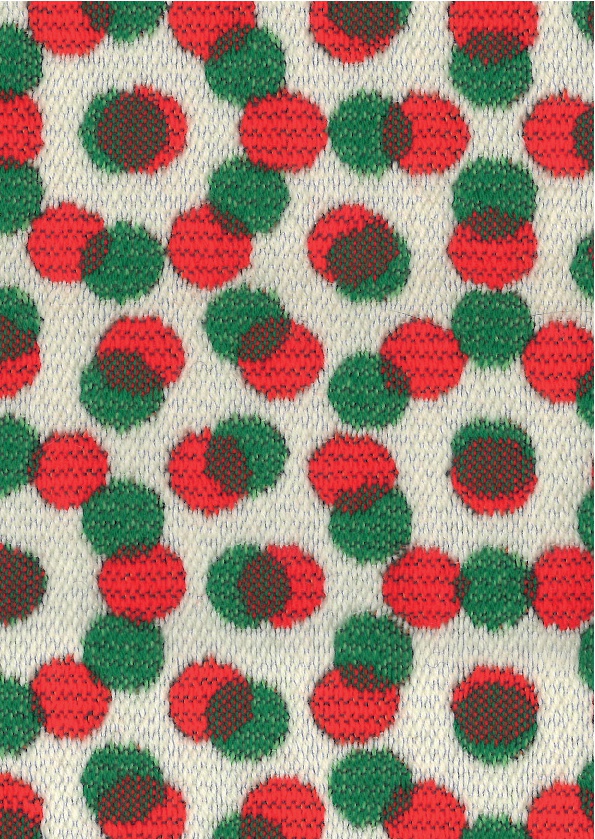Willem Oorebeek
'Geheugenspoor' een cyclus van 9 wandtapijten
29.10.2017 — 10.12.2017
[NL]
‘In onze samenleving zijn beelden, door toedoen van opeenvolgende technische ontwikkelingen, steeds meer tot consumptie- en wegwerpartikelen herleid. Lang geleden al, door de uitvinding van de boekdrukkunst, maar vanaf de 19de eeuw versneld, met fotografie, de fotokopie, de computer en de digitale procedés, kwamen de integriteit en authenticiteit van beelden onder druk te staan. Het oeuvre van de Nederlandse, in Brussel gevestigde kunstenaar Willem Oorebeek kan worden gelezen als een onderzoek naar hoe beelden zich onder die omstandigheden gedragen: hun kwetsbaarheid, hun overlevingskracht.’
In 2010 maakte Willem Oorebeek een reeks van negen wandtapijten voor het Ellipsgebouw van de Vlaamse overheid, in opdracht van het toenmalige agentschap voor Facilitair Management. ‘Het medium roept in de context van een (Vlaamse) overheidsopdracht een aantal associaties op: niet alleen ontwikkelden de oude Nederlanden vanaf de 13de eeuw op het gebied van tapijtkunst een rijke traditie, met wereldberoemde ateliers in onder meer Doornik, Brugge, Oudenaarde, en later Mechelen en Antwerpen; de kostbare wandtapijten werden gemeenzaam vervaardigd in opdracht van gezagdragers en overheden en moesten in pronk- en audiëntiezalen hun macht en aanzien onderstrepen. Oorebeek mag die referenties dan in het achterhoofd hebben gehouden, hij deed er verder zijn eigen zin mee: enerzijds wijkt zijn tapijtencyclus in meerdere opzichten van iedere “traditie” af, anderzijds krijgt zijn keuze voor het medium, in het licht van zijn oeuvre als geheel, een specifieke betekenis.’
‘Als bron voor de tapijten gebruikte de kunstenaar overwegend gevonden beelden van diverse oorsprong: kalenderbladen, een pagina uit een boek, tijdschriftcovers… Met aangepaste software werden de digitale beelden rechtstreeks omgezet in een weefpatroon, wat resulteerde in een gloednieuw en uniek “origineel”. Interessant is overigens te bedenken dat ook de historische gobelins het eindproduct waren van een lang proces van beeldproductie en -manipulatie (schetsen in diverse stadia, vervolgens geschilderd “karton” op ware grootte enzovoort).’
‘Oorebeeks reeks is geen verhalend ensemble, de jacquardtapijten hebben geen duidelijke volgorde en de kunstenaar verkoos oorspronkelijk ook niet om ze in een bij uitstek representatieve of publieke zone van het Ellipsgebouw onder te brengen.’ Hij trok er een ‘spoor’ mee door diverse vergaderzalen. ‘In de hoofden van de gebruikers van het gebouw is elk wandtapijt verbonden met een van de generieke werkruimtes, en kan het de “mentale reproductie” oproepen van een of meerdere andere: zo werkt het Geheugenspoor.’
LLS 387 toonde de cyclus voor het eerst publiek als één geheel. En zoals de gebruikers van het Ellipsgebouw de aparte werken in hun onderlinge verhouding enkel mentaal konden oproepen, werd de gehele cyclus uitgedaagd om dit op een ander niveau voor de bezoekers van LLS te bewerkstelligen, namelijk een spoor te trekken richting een nieuw hoofdstuk van LLS:
‘Geheugenspoor’ van Willem Oorebeek was de laatste tentoonstelling die in de ruimte gelegen in de Lange Leemstraat 387 plaatsvond. LLS 387 verhuisde op het einde van 2017 naar de Paleisstraat 140 en werd ‘LLS Paleis’. Daar zal – onder de nieuwe leiding van Stella Lohaus – de eerste tentoonstelling openen begin maart 2018.
Citaten: Catherine Robberechts in Kunst in het Ellipsgebouw, Brussel, Team Vlaams Bouwmeester (kunstcel), 2010, pp. 29-30 en in Kunst in opdracht 2006 -2013, Brussel, Team Vlaams Bouwmeester (kunstcel), 2015, pp. 64 en 158-163.
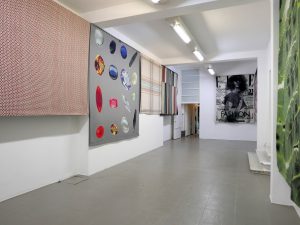
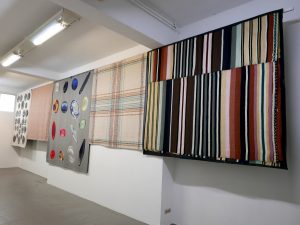
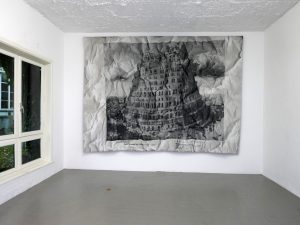
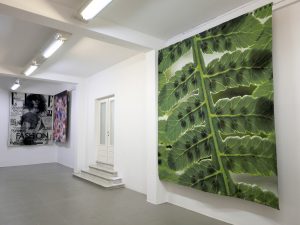
[EN]
“In our society, with the help of a series of technological developments, images have increasingly been reduced to consumer goods and disposables. Long ago, through the invention of the printing press, and more rapidly from the 19th century on, with photography, photocopies, computers and digital techniques, the integrity and authenticity of images came under pressure. The oeuvre of Willem Oorebeek, a Dutch artist residing in Brussels, can be read as research into the way images behave under these circumstances: their vulnerability, their staying power.”
In 2010, Willem Oorebeek made a series of nine tapestries for the Ellips building of the Flemish government, commissioned by the then Agentschap voor Facilitair Management [the General and Technical Services Department]. “In the context of a (Flemish) public commission, the medium evokes a number of associations: the historical United Kingdom of the Netherlands not only developed a rich tapestry art tradition from the 13th century on, with world-famous workshops in Tournai, Bruges, Oudenaarde and later on Mechelen and Antwerp, among other cities; the valuable tapestries were usually manufactured by order of authorities or governments and were to underline their power and prestige in drawing rooms and reception halls. Oorebeek may have had these references in mind, but apart from that he did as he pleased: on the one hand his tapestry cycle deviates from the ’tradition’ in many respects, on the other hand his choice for the medium, in the light of his oeuvre as a whole, acquires a specific meaning.”
“As a source for the tapestries, the artist mainly used found images from different origins: calendar pages, a page from a book, magazine covers, … By means of specially adapted software the digital images were transposed into a weaving pattern, resulting in a brand new and unique ‘original’. It is, for that matter, interesting to think of the historical Gobelin tapestries as similar end products of a long process of image production and manipulation (sketches on different levels, then full-size painted ‘cardboard’ and so on).”
“Oorebeek’s series is not a narrative ensemble; the Jacquard tapestries do not have a clear order, and originally the artist did not intend to house them in a pre-eminently representative or public zone in the Ellips building.” He left ’tracks’ in several meeting rooms. “In the minds of the users of the building, every tapestry is connected to one of the generic workrooms and can evoke the ‘mental reproduction’ of one or more of the other rooms: that is how the Geheugenspoor takes effect.”
LLS387 is showed the cycle as a whole in public for the first time. And in the same way that the users of the Ellips building could only mentally evoke the separate works in their mutual relation, the whole cycle was now challenged to do this on another level for the visitors of LLS, namely by leaving tracks towards a new LLS chapter:
Geheugenspoor by Willem Oorebeek was the last exhibition at the space in Lange Leemstraat 387. LLS 387 moved to Paleisstraat 140 at the end of 2017 and became ‘LLS Paleis’. There – under the new direction of Stella Lohaus – the first exhibition will open in early March 2018.
Quotes: Catherine Robberechts in Kunst in het Ellipsgebouw, Brussels, Team Flemish Government Architect (art cell), 2010, pp. 29-30 and in Kunst in opdracht 2006 -2013, Brussels, Team Flemish Government Architect (art cell), 2015, pp. 64 and 158-163.
Met dank aan/With thanks to: Liska Brams, Kris Cuylits, Bram Denkens, Oscar Hugal en Sietske Van Aerde.
Met de ondersteuning van de Vlaamse overheid en de Sympathisanten van LLS 387
Gesponsord door Duvel Moortgat
